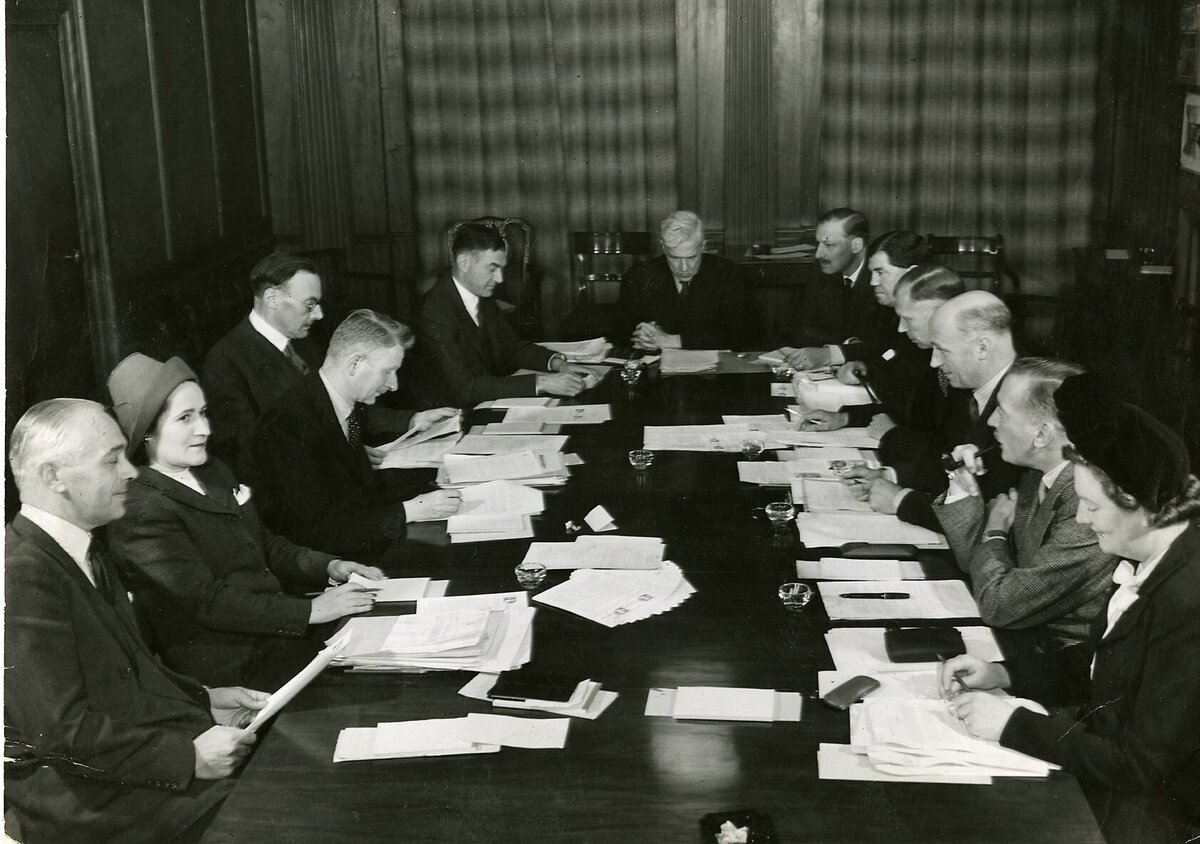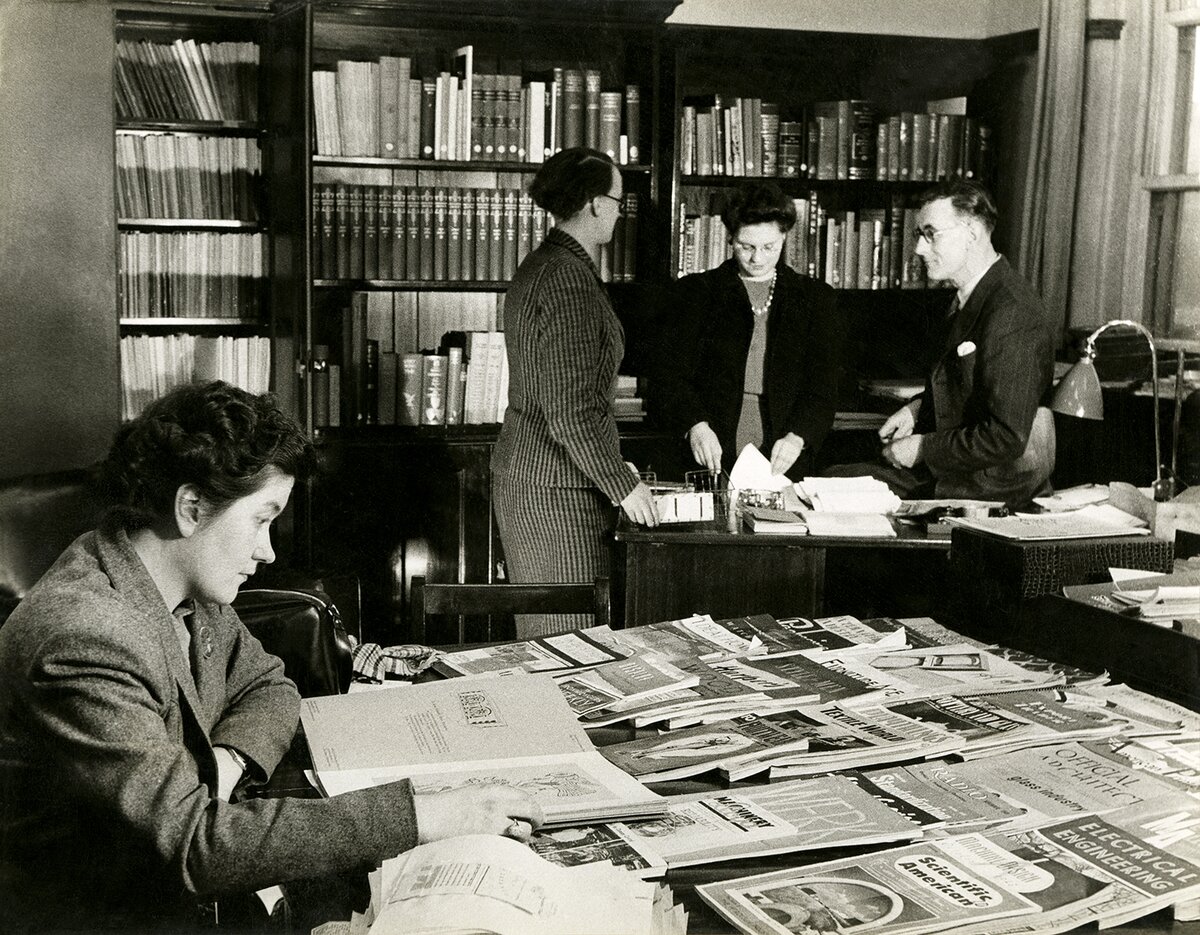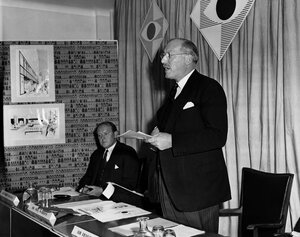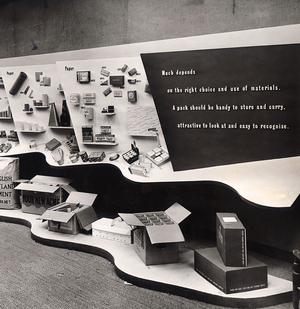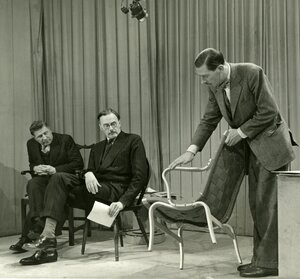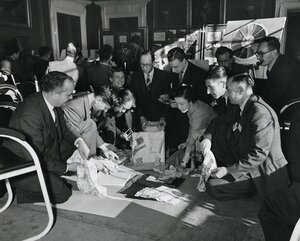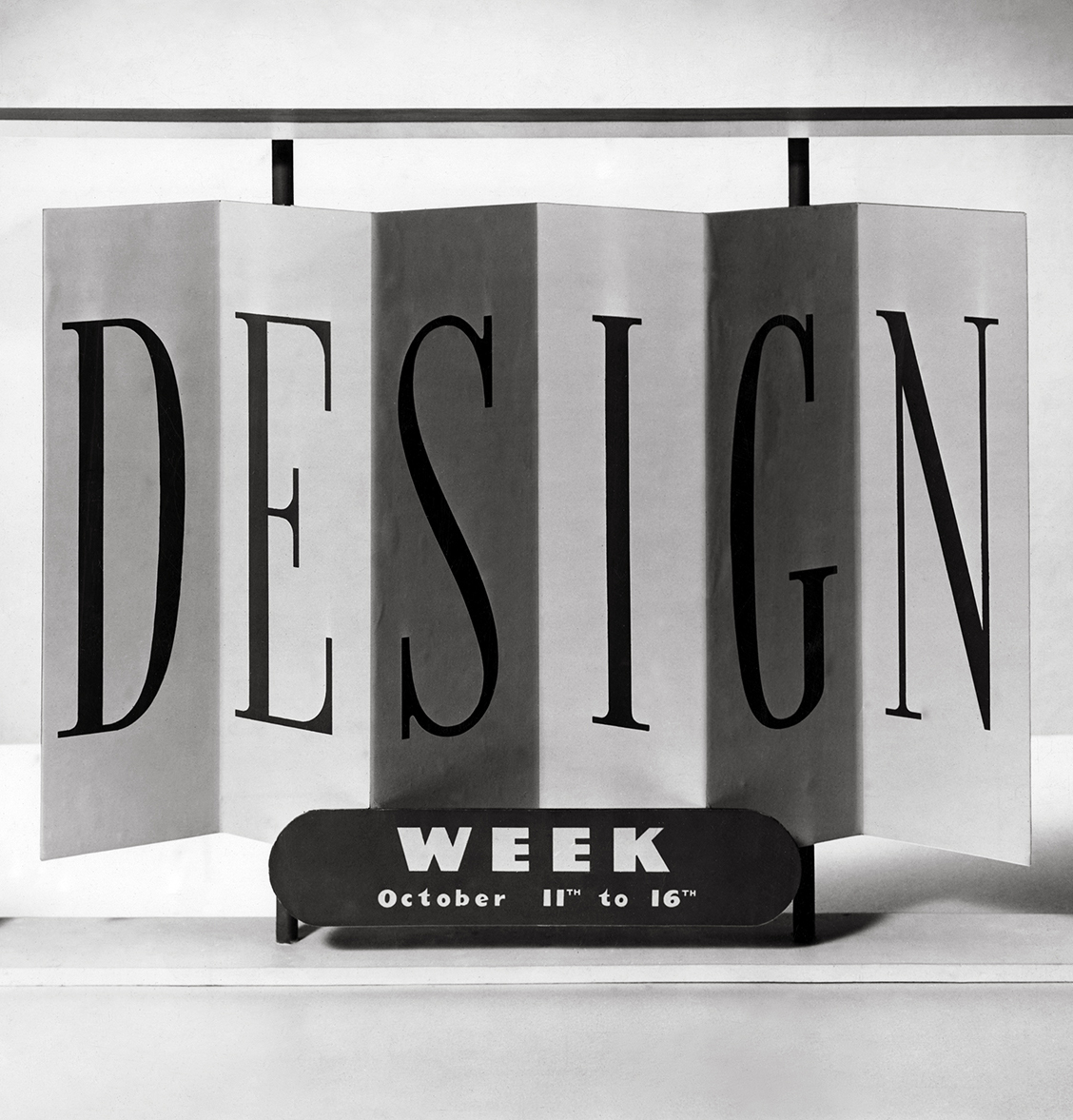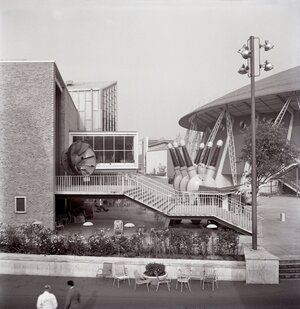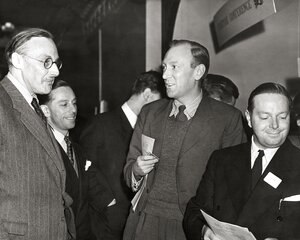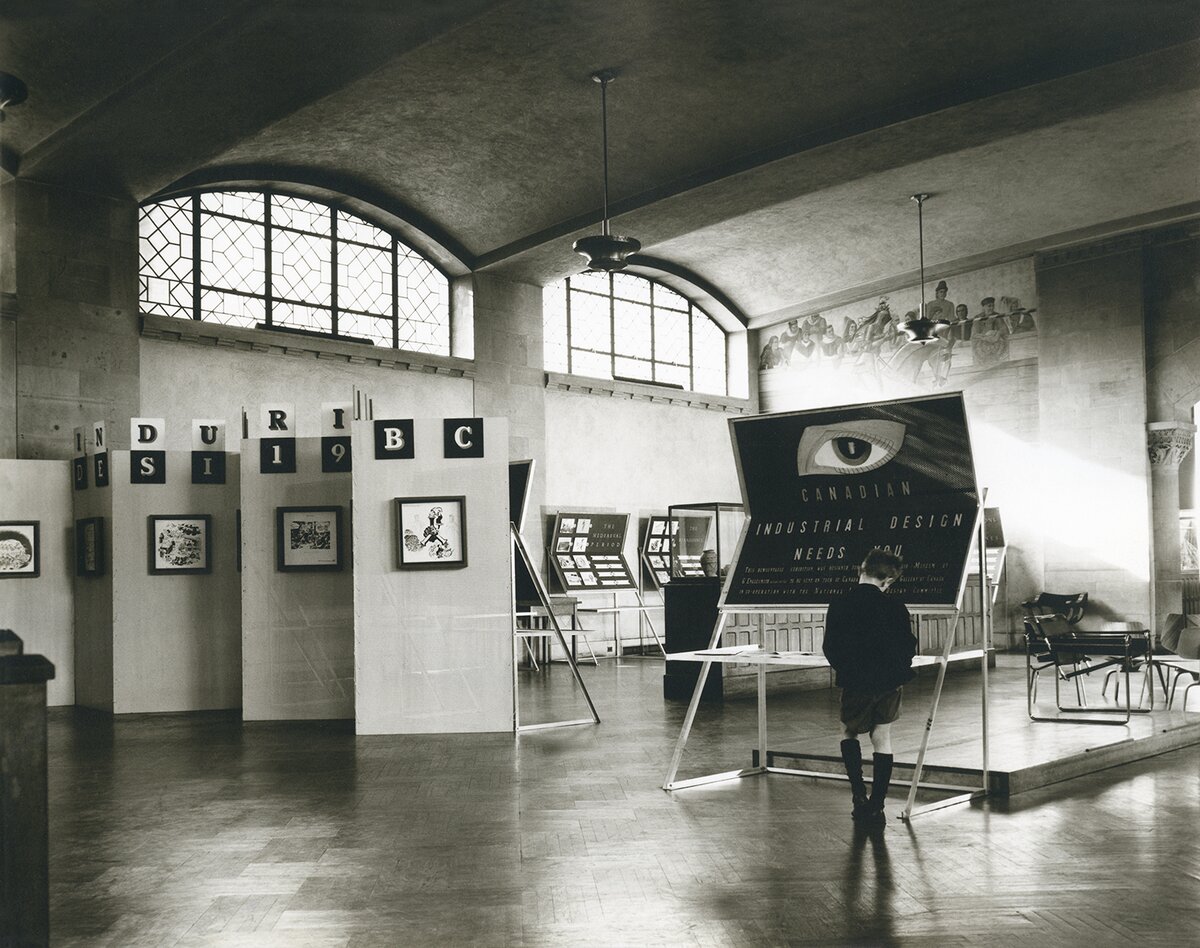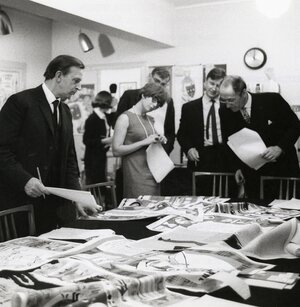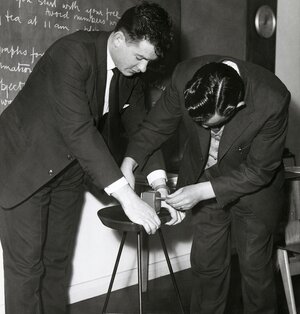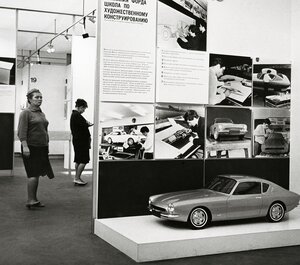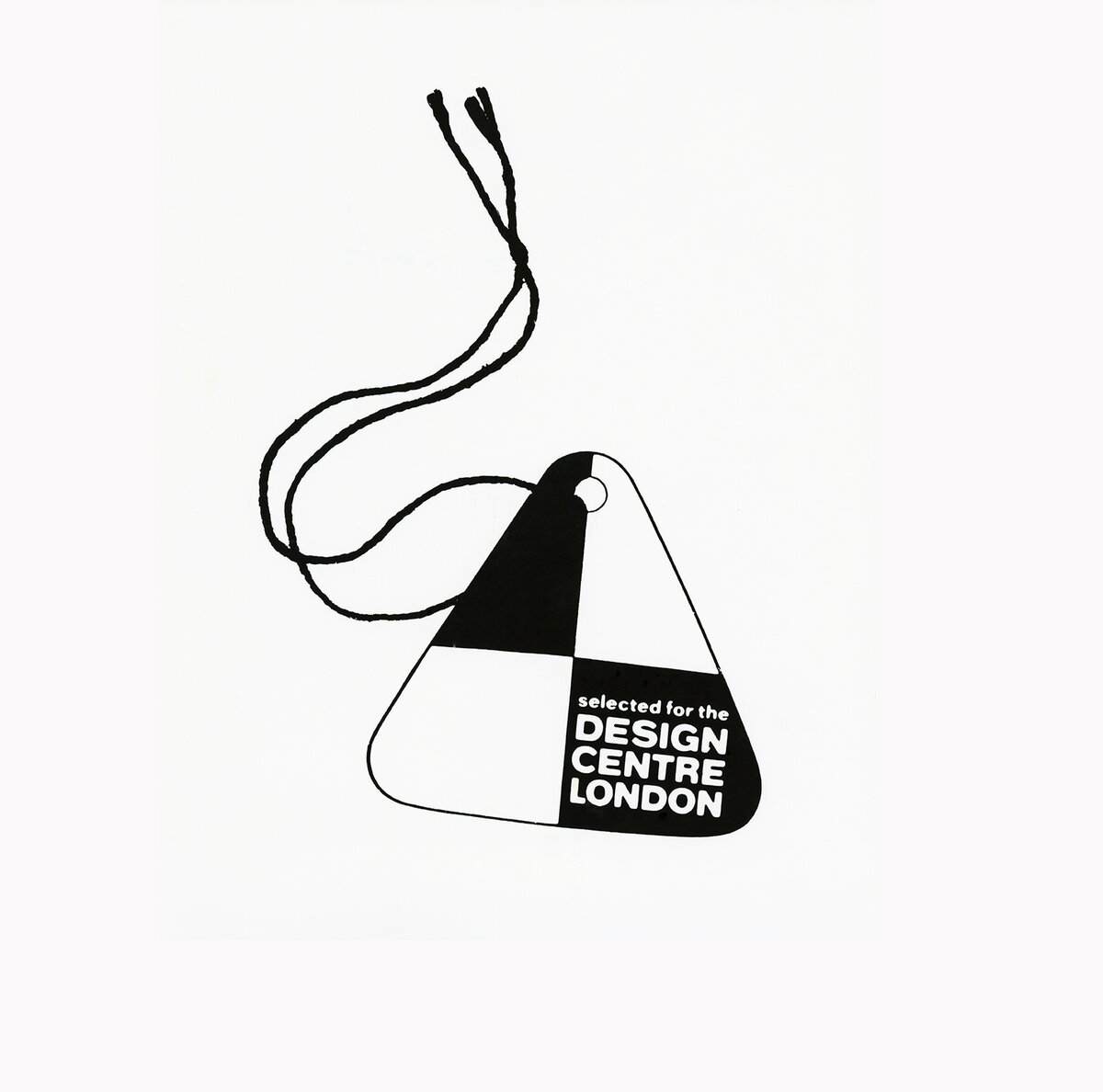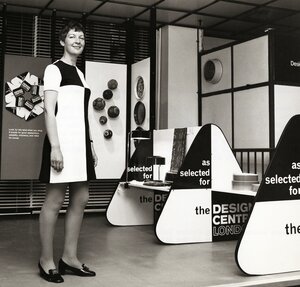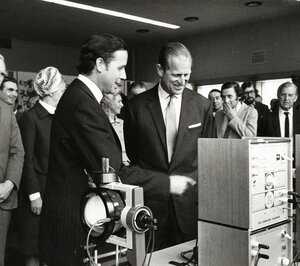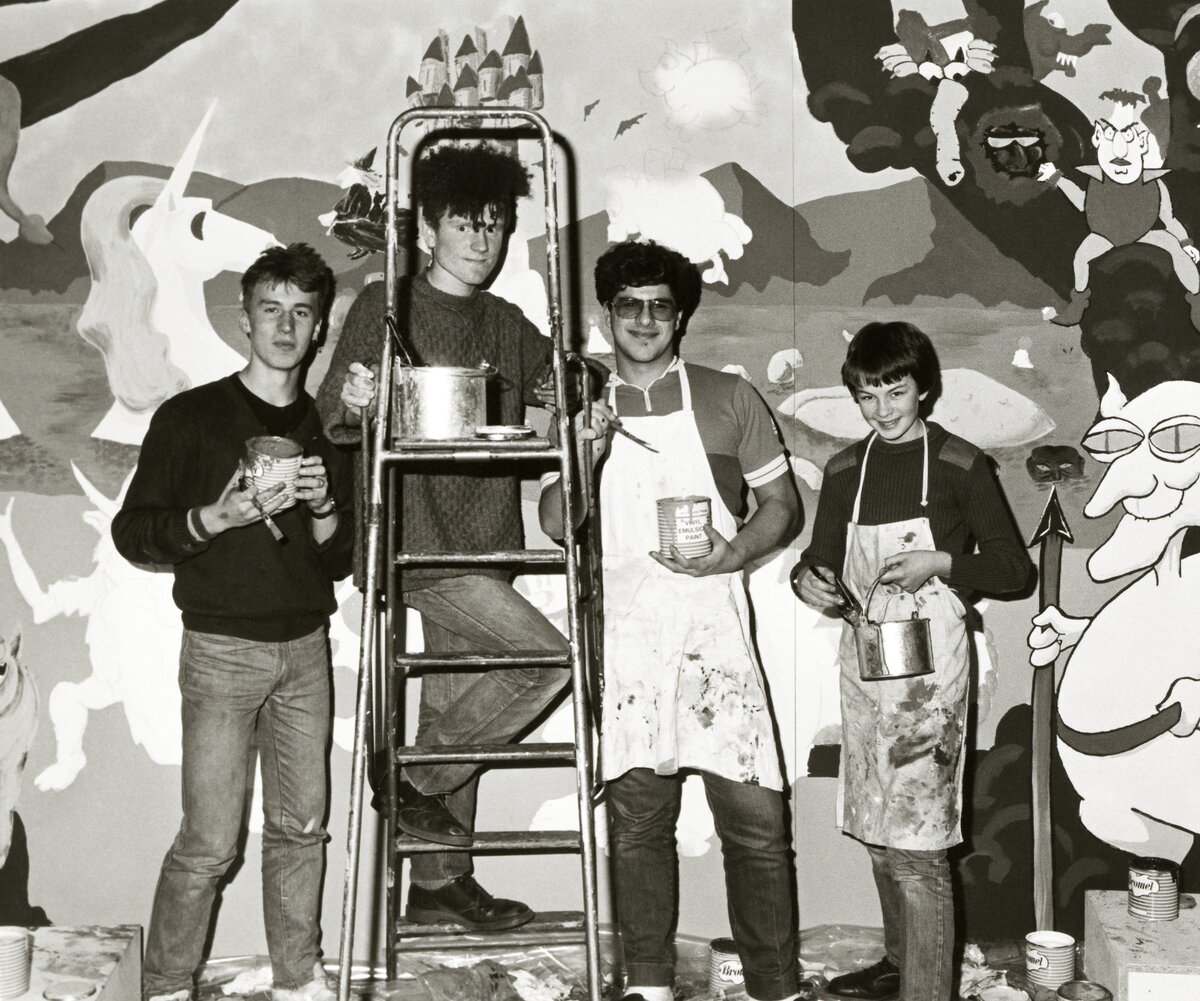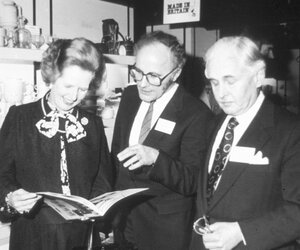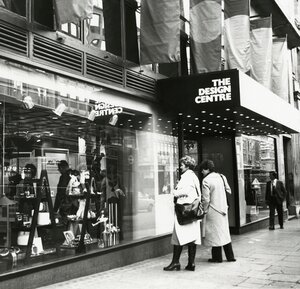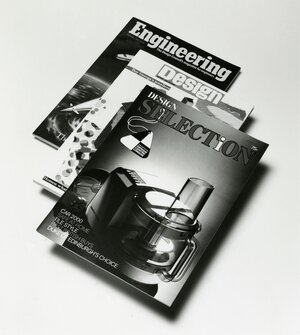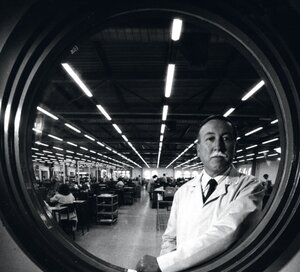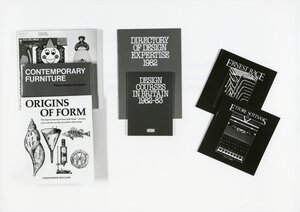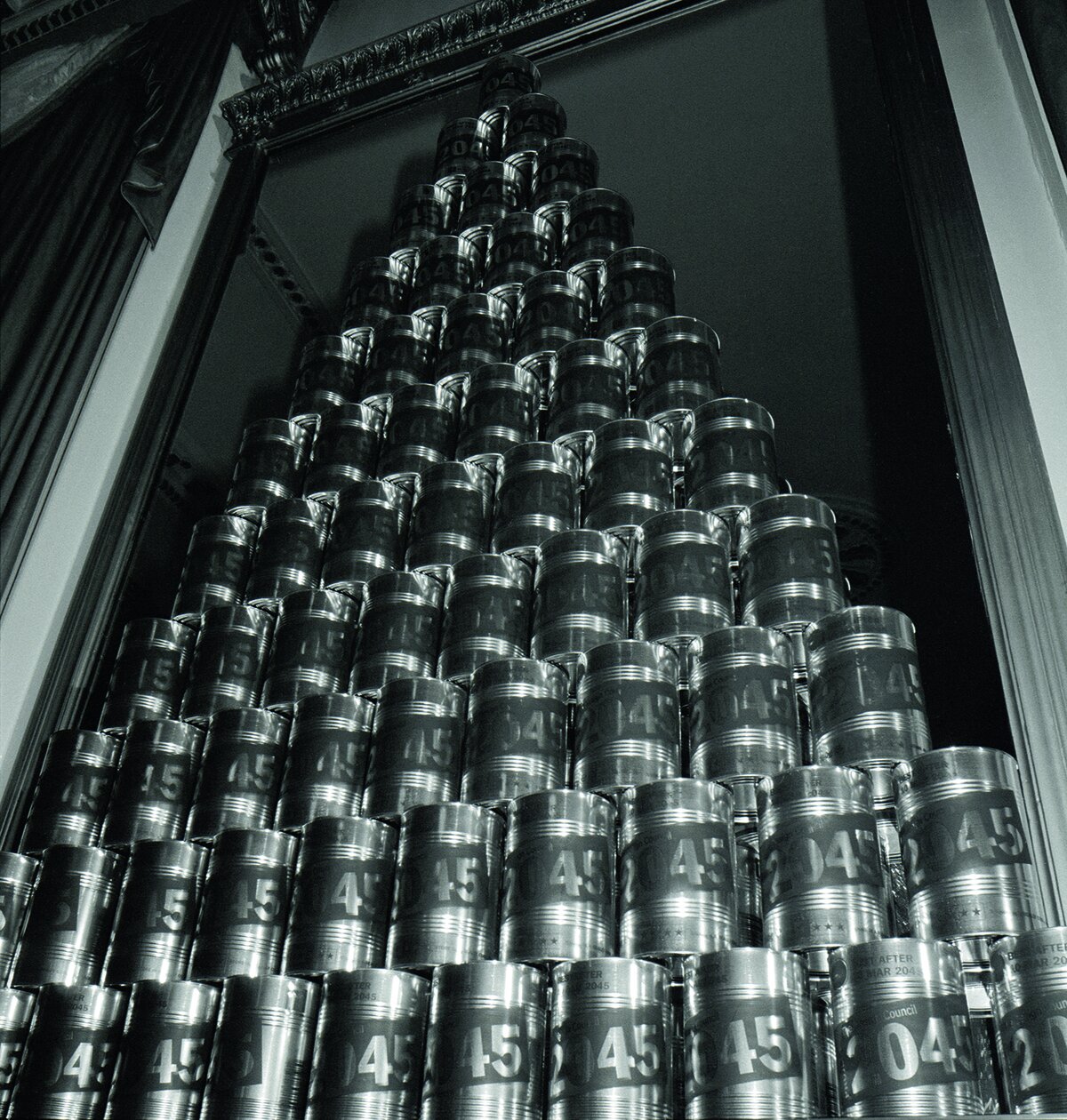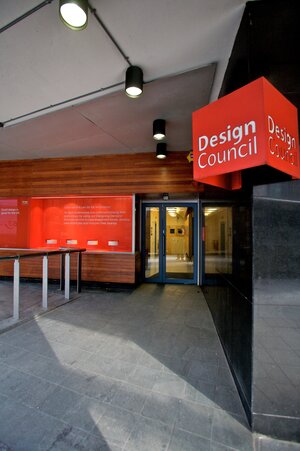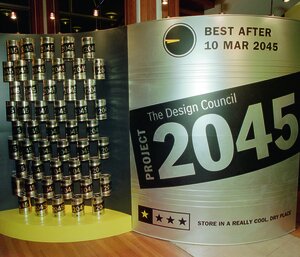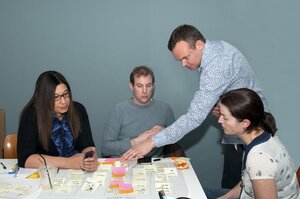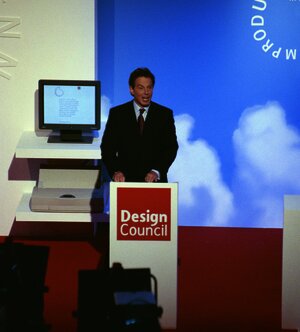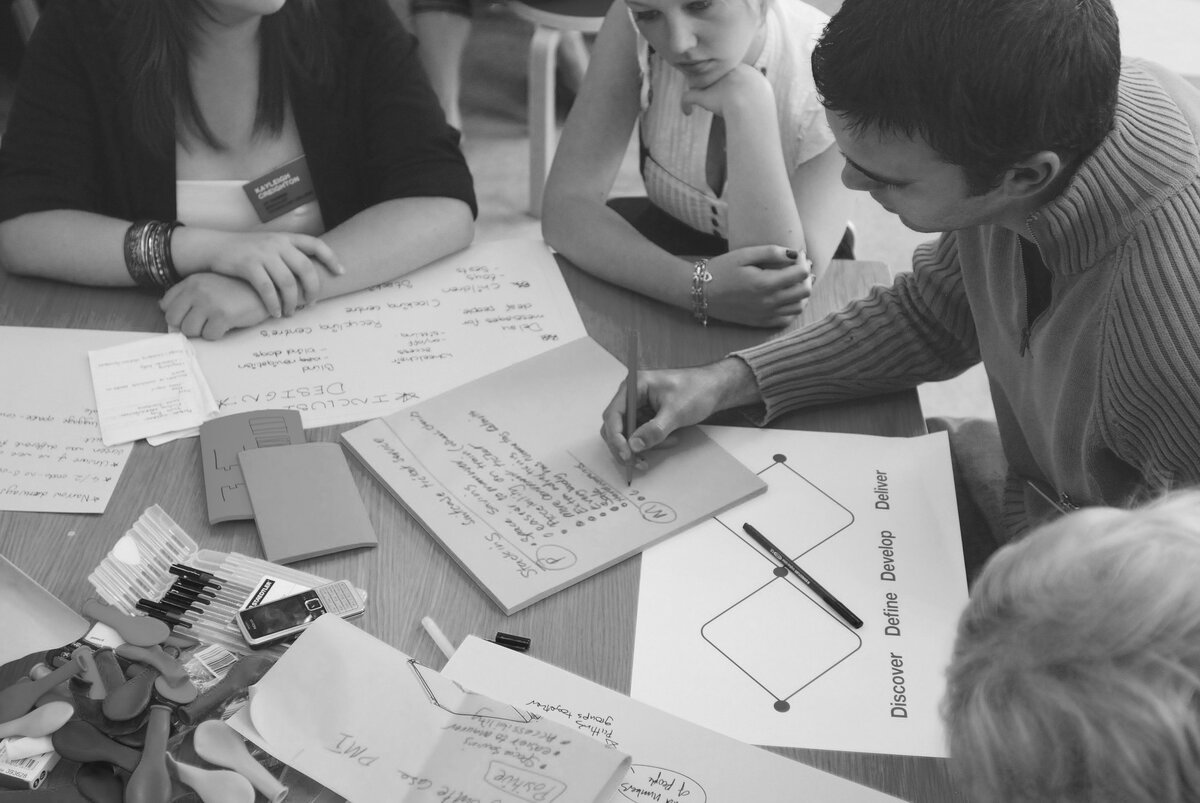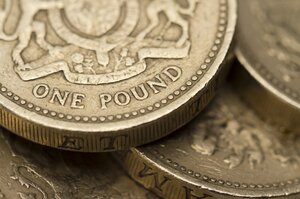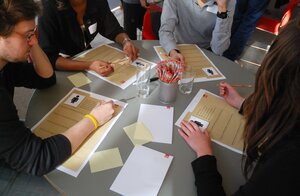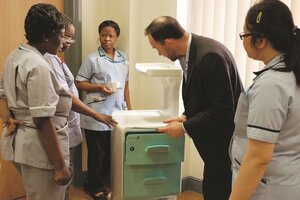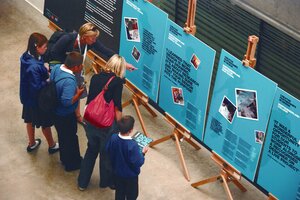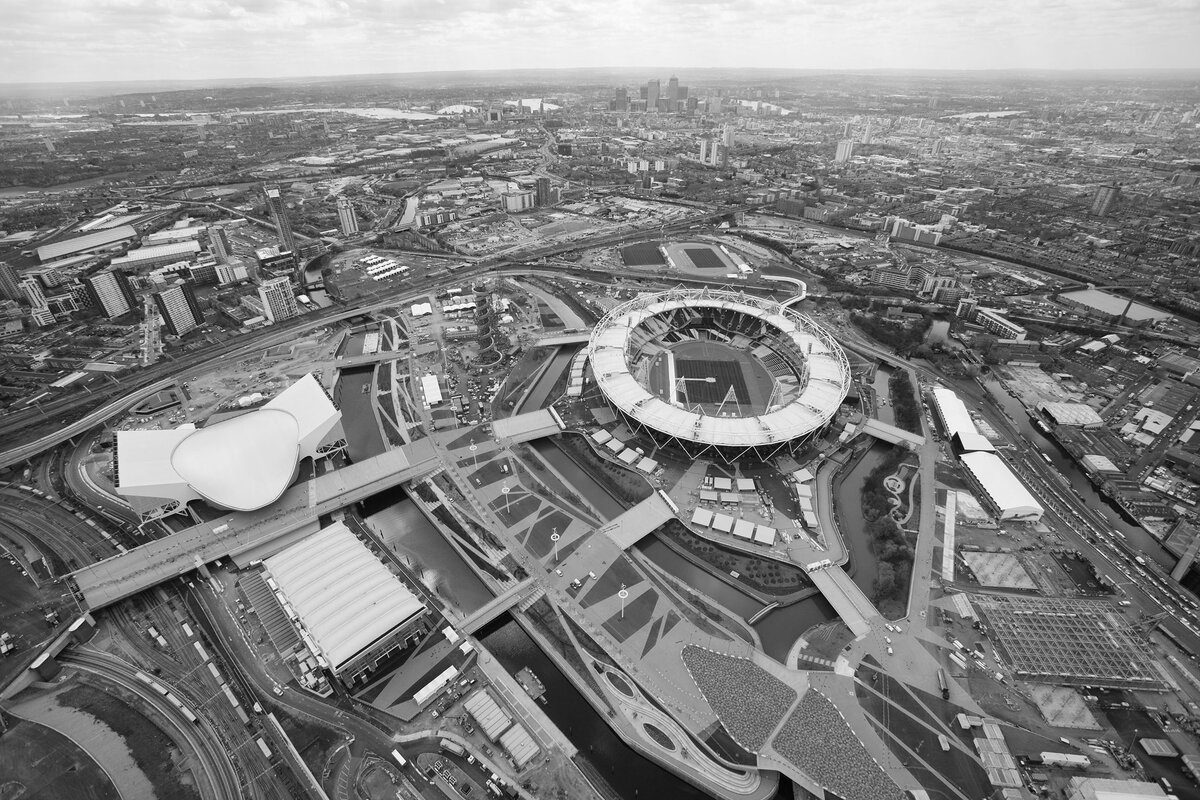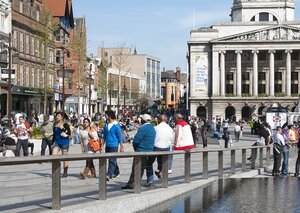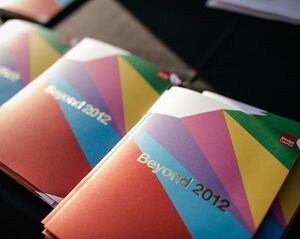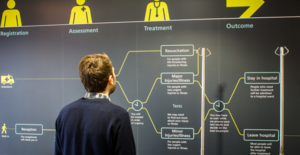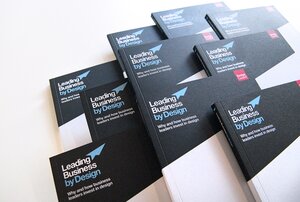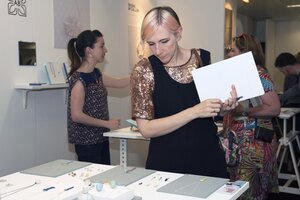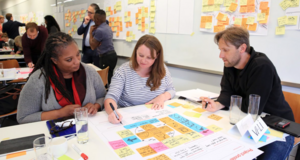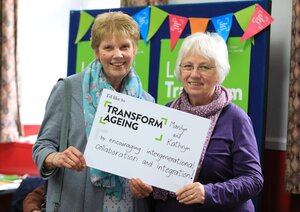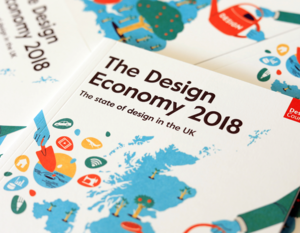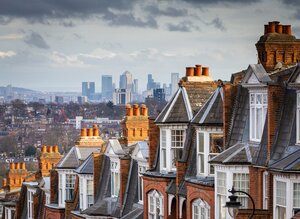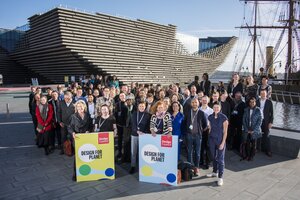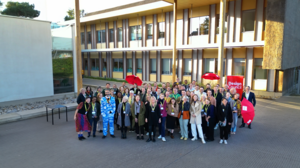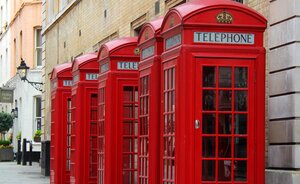Timeline
Discover the legacy of ground-breaking events and initiatives produced since our founding in 1944.
Our first mission was “to promote by all practicable means the improvement of design in the products of British industry”
The Design Council was created in 1944 by Winston Churchill’s wartime government to tackle the biggest challenge of the time, the post-war economic recovery.
Over the following decades, the Design Council became the national strategic advisor for design.
This image shows the first ever board meeting including Chairman of the Housewives Committee, Margaret Allen.
Follow the timeline
1940s Overview
1944
Laying the foundations
In December 1944, the British government anticipated a fiercely competitive post-war world, where it would need to produce high-quality products that were attractive to both domestic and foreign markets. To oversee this mammoth task Hugh Dalton, President of the Board of Trade, founded the Council of Industrial Design (‘The Council’).
1946
Getting the message out
In autumn 1946, the first high-profile project organised by the Council opened at the Victoria and Albert museum in London.
The Britain Can Make It exhibition promoted and displayed a broad range of the best in contemporary British design and manufacturing, including clothing, household furnishings, office equipment and civil transport. The show’s subtitle, ‘Good Design and Good Business’, was significant to the Council’s vision – design was the key to driving British industry.
The exhibition was a great success, attracting nearly one and a half million visitors, highlighting the general public’s newfound interest in how design could improve their lives.
1947
The media embraces design
Following the success of the Britain Can Make It exhibition and sensing the thirst for improved product and service design, the Council implemented an intense programme of exhibitions, conferences, courses and publications. This included Design magazine (1949-99), published to ‘educate’ British manufacturers, retailers and the public on design matters.
The Council’s Information Division, responsible for developing a national audience for well-designed products, collaborated with the BBC to create a series of educational programmes to bring the idea of ‘good design’ straight into British homes.
1947
Education, education, education
Reforming design education in Britain and providing adequate training for designers were regarded as crucial to the production of high-quality industrial products capable of competing in a post-war global market.
Design education was top of the Council’s agenda, with a comprehensive programme of specialist courses for designers and design appreciation seminars for educators, manufacturers and retailers.
1950s Overview
1951
The Festival of Britain
In the summer of 1951, the Council was integral to the organisation of the Festival of Britain. This nationwide series of events and exhibitions celebrated 'the British contribution to civilisation, past, present and future, in arts, science and technology, and in industrial design'.
The Council managed the Festival’s centrepiece, selecting the street furniture, graphics, signage and the industrial products on display at the South Bank Exhibition in London, which received 8.5m visitors over a period of five months.
1953
Professionalising design
Working in tandem with the Council’s Information Division, the Industrial Division focused on persuading British manufacturers of the importance of raising their products’ standards by employing professional designers and design consultants.
A programme of national and international design conferences organised by the Council played an important role in advising as well as promoting the value of design to British industrialists and retailers, redefining it as a driving force behind the economy.
1956
New HQ in Haymarket
The Design Centre in Haymarket, London provided the Council with headquarters and an opportunity to showcase and endorse contemporary design on a permanent basis.
Opened in 1956 by Prince Philip, the Duke of Edinburgh, the Centre staged a number of exhibitions that proved very popular, touring major department stores in towns and cities across the UK under the theme 'The Design Centre Comes To...'. In 1957, a further Design Centre opened in Glasgow.
1959
The Prince Philip Designers Prize
The prize was created in 1959 by Prince Philip in response to post-war austerity. Initially known as The Duke of Edinburgh’s Prize for Elegant Design, the award recognised products that stood out from the largely functional designs of the late 1950s. Its aim was to stimulate and reward elegant solutions to design problems.
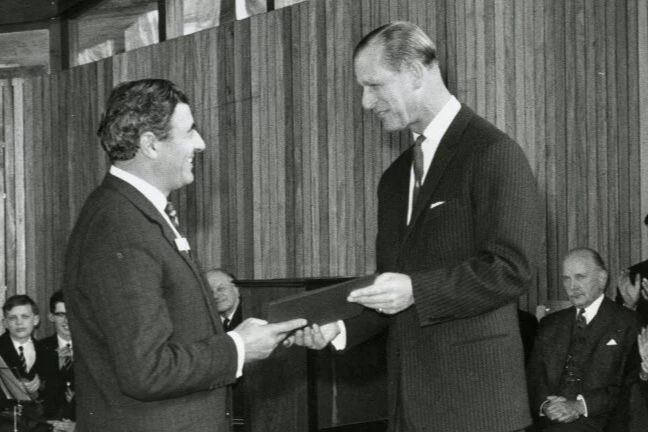
1960s Overview
1960
Changing priorities
The 60s saw improved living standards, a buoyant demand for high-quality British goods and increased investment in scientific research as well as technological development. None of these factors, however, could prevent the decline of the British manufacturing industry and the shift towards a service sector economy.
The Council had achieved one of its goals of raising awareness of design within the general public. It then turned its energies towards industry and education.
1961
The Design Index
One of the Council’s most successful initiatives of the decade, the Design Index was an exhibition of well-designed products for trade buyers and members of the general public. Each product was photographed or shown with a sample and accompanied by relevant information at the Design Centre.
The Design Index was instrumental in the Council’s efforts to support British-made goods, encouraging manufacturers to invest in product development and designers.
1962
Design and the rise of technology
Technological innovation was integral to the production of new and better products. In order to promote awareness in industry of Britain's technical resources and transfer of technology, the Council increasingly focused its educational agenda on exhibitions, congresses and courses promoting links between industrial design, technology and engineering.
1964
Exporting British design
During the 1960s, as traditional export markets continued to change, the Council devised a targeted exhibition programme abroad on behalf of the Board of Trade and the British Council in an effort to promote British goods in existing as well as new export markets, including Russia and Nigeria.
At home, the Council’s exhibition programme increasingly included shows sponsored by manufacturers.
1970s Overview
1970
Showcasing excellence
To recognise excellence in British manufacturing, in 1964 the Council had introduced ‘the Swingtag’, symbolising its endorsement of quality products selected for the Design Index.
A simple, bold design of a black and white quartered triangle, the Swingtag allowed manufacturers to promote the official mark of quality design in their advertising and retail activities. By 1970, the Swingtag had featured on thousands of products.
1972
The new design scholars
By 1972, the Council of Industrial Design’s remit had evolved so much that it decided to change its name to 'Design Council', reflecting its focus on the promotion of links between industrial design, technology and engineering.
During the 70s, the Design Council undertook the management of a number of prizes, awards and scholarships on behalf of external institutions and companies, including the British Design Awards, the Duke of Edinburgh Prize for Elegant Design, Schools Design Prize, BICC Engineering Design Prize and the Leverhulme Travelling Scholarships in Industrial Design.
These awards and scholarships were crucial in publicising outstanding achievements by British industry as well as supporting young designers and engineers.
1973
The Design Council in print
The economic stagnation of the 1970s affected product development in the consumer and contract goods industries. In 1973, the Design Council set up a Design Advisory Service offering direct help and advice to manufacturers.
With the acquisition of a manufacturing magazine called Engineering and the publication of the Design Guides, the Design Council was able to provide industrialists and designers with updated technical information on engineering design, from conception to market.
1980s Overview
1980
The dawn of social design
During the course of the 80s, Design Council added a number of exhibitions to its traditional programme, focusing on contributions made by designers to address social, regeneration and environmental issues.
The ‘Vandalism’ exhibition in 1982, ‘Design for Need’ and ‘Regeneration by Design’ in 1985 and ‘The Green Designer’ in 1986 reflected the broader concerns of the period alongside practical and sustainable design proposals to tackle these issues.
1981
Slowdown
The recession of 1981 severely hit the British manufacturing industry, restricting its investment in new design and development work.
1981
A one-stop shop for design
Throughout the 80s, Design Council’s Design Centre continued to play an important role in endorsing British products and manufacturers, focusing on excellence in design through exhibitions and awards.
By 1985, the Design Centre included a bookshop, a shop, and the Innovation Centre - a regularly updated showcase for selections of work from designers, companies and academic institutions.
1983
Design takes a lead
Poor design was a major factor in Britain’s industrial decline at home and abroad, as customers became more demanding, expecting both quality and value for money. It was clear that major changes needed to be made.
Design Council’s flagship magazines, Design and Engineering, broached the subject of poor design with industry directly - successfully addressing problems such as funding the development of innovative products, the implications of new technologies in product design and how to better educate industrial designers.
However, the short-lived recovery of the late 1980s ended abruptly on ‘Black Wednesday’ in September 1992.
1986
The rise of the new independents
Support for British companies remained Design Council’s primary objective. The Design Advisory Service, which brought together manufacturers and external consultants, was largely responsible for the development of independent design consultancies in the UK.
In the early 90s, this service was reorganised into a regional network of support organisations for manufacturers. Led by senior industrialists, these focused on three main sectors: clothing and textiles, medical equipment and furniture.
1987
Enhancing public understanding
Design Council’s publishing policy aimed to provide the best possible educational support for design at all levels. A vast range of publications included engineering design guides, product catalogues and books on design theory and practice for professional audiences.
Various books and slide sets were produced specifically for use in secondary schools and colleges, while the Design Centre sold books aimed at the general public as well as design professionals.
1990s Overview
1993
The Sorrell Review
In 1993, the government requested a far-reaching review of Design Council and Michael Heseltine MP invited John Sorrell - Design Council member and founder of the successful design agency Newell and Sorrell - to lead it.
Presented in 1994, The Future Design Council resulted in a much leaner and more agile collaborative thinktank organisation, chaired by Sorrell himself. Its regional offices were closed, as was the Design Centre in Haymarket and in early 1998 the newly structured organisation moved to offices in Bow Street, Covent Garden.
The third and fourth floors of the former telephone exchange were converted to office space and designed by interior designer Ben Kelly, whose work won FX International Interior Design and Design Week Awards.
1994
Focus on the customer
Following The Future Design Council report, Design Council was structurally reorganised with a new strategic remit of research, lobbying and facilitating relationships between sectors.
To promote competitiveness, it organised Design in Business Week, an annual programme of events across the UK providing access to the latest research and best practice, from benchmarking design to new product development and understanding customers’ needs.
1995
Project 2045
In 1995, Design Council invited 2,045 individuals, schools and organisations to imagine what the world would be like in the year 2045. Their ideas were sealed in time capsules which would be opened in 50 years’ time.
The British Museum selected 50 capsules to share with industry to help inspire design for the next century.
1996
Building a national knowledge network
Responding to the government’s new focus on improving small and medium-sized enterprises’ competitiveness and skills, in 1996 Design Council organised Design Links. This national network supplemented Business Links support services, many of which had a Design Counsellor providing practical and advisory design services to local businesses.
1998
The Millennium Products
In 1998, Design Council launched an award to search for the most innovative, creative and well-designed products to mark the end of the millennium. Over 4,000 products were submitted and 1,012 were selected for the award - including the Skeleton Bobsled and the Millennium stamps.
In December 1999, the Millennium Products were launched at the Millennium Dome by the then Prime Minister, Tony Blair.
The products were exhibited in a site adjacent to the Millennium Dome throughout 2000.
2000s Overview
2001
Design and the Creative Industries
Such was the interest in the products that had received Millennium Products status, in 2001 Design Council launched its 'Great Expectations' exhibition: a touring showcase that included many of them as well as new innovations.
Commissioned by Design Council and curated, designed and managed by Casson Mann, the installation consisted of a 54m banqueting table covered with 100 objects chosen to represent the very best in British design, including Marks Barfield Architects' London Eye, Marion Deuchar's repackaging of George Orwell's novels for Penguin Books, Seymour Powell's Bioform bra, Thomas Heatherwick's Plank chair and Lambie-Nairn's BBC2 brand idents.
First installed in New York’s Grand Central Station, Great Expectations subsequently toured the world between 2001 and 2002.
2005
The value of design to the economy
In 2005, Sir George Cox led a review of the contribution of design, innovation and creativity to the UK economy. The result was 'The Cox Review', an influential report that was well received and referred to globally.
Increasingly, Design Council focused on identifying and demonstrating design's value to the UK economy.
2006
The Designing Demand initiative
As a result of the Cox Review, in 2006 Design Council developed and launched 'Designing Demand' - a support programme for small and medium-sized companies helping them to use design more strategically within their businesses to unlock new value.
The programme supported more than 2,000 businesses between 2007 and 2011 and had a strong commercial impact. For every £1 spent on design by businesses participating in the programme, they delivered £5 in exports, £4 in net operating profit and £20 in turnover.
Designing Demand is now part of the Design Leadership Programme.
2007
Designs of the time
In 2007, a social innovation programme called Designs of the Time (Dott) started in the North East region, funded by the regional development agency One NorthEast. The programme brought designers together with communities and service providers to tackle problem areas such as dementia, sexual health, schools and unemployment.
Dott was a huge success, with many projects turning into new services, and was repeated in the South West in 2008.
Also in 2007, a new in-house research and development interdisciplinary team, RED, explored approaches to economic and social issues through design innovation. RED papers delved into a wide range of issues including health and sustainability.
2008
Solving social challenges with design
Since the launch of its Design Challenges open competitions, Design Council has helped to develop a number of products and services addressing a wide range of social issues on a national scale.
These have included the development of well-designed and easy to clean hospital furniture in partnership with the Department of Health, and the development, in collaboration with Nominet, of digital services to tackle youth unemployment.
2008
The Design Skills Alliance
In 2008, Design Council funded and set up the Design Skills Alliance, a three-year good design practice campaign, in collaboration with the Creative & Cultural Skills Council.
This scheme included a range of initiatives aimed at improving design training from primary through to higher education and professional development through a range of tools, information and advice for designers.
2010s Overview
2010
CABE joins the Design Council
In 2010, following the election of a coalition government in a challenging economic climate, there was a far-reaching review of all publicly funded organisations. While many organisations were culled, the government considered Design Council to have demonstrated and delivered value, meaning it survived.
It was transitioned into a charity, retaining its Royal Charter, and at the same time it merged with Cabe: the Commission for Architecture and the Built Environment.
2010
The Design Leadership Programme
The Design Leadership Programme is a cross-sector support service. Design Council places hand-picked design experts from across the country into organisations to help them achieve their goals - whether those be growing a business, delivering better public services or developing breakthrough technology and taking it to market.
The programme has worked with more than 1,000 businesses to help them unlock potential, as well as nearly every local authority in the country and some of the top research universities in the UK.
To support the drive for innovation in the UK, Design Council created specialist streams to support technology start-ups and assist universities and research institutes to commercialise their research.
2012
Design’s role in the Olympics
London 2012 was a defining moment in modern British history. Design Council Cabe played a significant role by reviewing every piece of construction within the Olympic Village, ensuring it met quality standards and made the most of the infrastructure investment.
To celebrate the contribution of the design sector to London 2012, Design Council created the Beyond 2012 website to capture the stories, energy and passion of the people who worked behind the scenes to make the games such a success.
2013
Designing with the NHS
Building on previous work in the healthcare sector, Design Council’s Challenges team tackled the pressing issue of violence and aggression towards frontline hospital staff, which costs the NHS an estimated £69m per year.
It commissioned a multi-disciplinary design team, led by PearsonLloyd, to deliver a two-pronged solution called ‘A Better A&E’. This incorporated a ‘Guidance Solution’ - signage to guide and reassure patients, and a ‘People Solution’ - a programme to support staff in their interactions with patients.
After one year, 88% of patients interviewed said that the new signage clarified the A&E process, while 75% of patients said it made the wait less frustrating. Violence and aggression was significantly reduced in the two pilot A&E units and has since been rolled out in other Trusts around the UK.
This project won Creative Review's Best in Book award in 2014.
2014
Design Summit
In 2014, Design Council investigated how world-class companies such as Barclays, O2, Jaguar Land Rover, Virgin Atlantic, Philips and Diageo are benefiting from the strategic use of design. The report Leading Business by Design became the basis of its 2014 Design Summit at the British Museum, where the topic was explored further by a stellar cast of designers, business people and industry leaders.
2015
Designing sustainable cities
The power of design can be realised at every scale. In response to the government's City Deals, which gave new freedoms and flexibilities to cities around the UK, Design Council developed a new City Model to support local authorities in delivering well designed places, infrastructure and economic growth. Design Council piloted this new approach with the City of Oxford and the Royal Borough of Greenwich and is now working with cities around the country to help them plan healthy, sustainable places for the future.
2015
The next generation: Shooting stars
At Design Council, we are always looking for new talent and fresh thinking that could benefit design and the world around us. As part of our 70th celebrations, we sought out 70 up-and-coming designers from a variety of disciplines who we believe have a fantastic future ahead of them – our Ones to Watch.
We are paying tribute to our roots by launching a product innovation fund. Design Council Spark is an accelerator programme that will help inventors bring their brilliant product ideas to life.
We also used our landmark anniversary as an opportunity to consider design’s role in the 21st century. We asked some of the world’s most influential and visionary thinkers to share their insights in a series of special essays and events.
2015
The Design Economy
In 2015, Design Council released The Design Economy – our research report on the value of design to the UK economy. It expanded on our previous research by looking beyond the traditional definition of the design sector. In doing so, it provideed the most thorough and accurate view of design's contribution to the UK economy ever produced.
The research measures the value of design using gross value added and statistics relating to productivity, turnover, employment and exports of goods and services. For the first time, The Design Economy shows the breadth and depth of design’s contribution to the UK.
2015
Design in the Public Sector
We commenced our partnership with the Local Government Association to introduce design to initially make services more people-centred, and then work more systemically with local partners and communities to address big challenges such as health inequalities or climate change.
Over 7 years over 90 local public sector teams have gone through the programme. 85% of participants thought design approaches were ‘very relevant’ to their work afterwards, compared to 42% before.
2017
Transform Ageing
Transform Ageing, funded by The National Lottery Community Fund is a pioneering programme taking a community design-led approach to improve people’s experience of ageing. It brought together people in later life, their friends, families, carers, social entrepreneurs and public sector leaders to explore, define and develop new solutions that support aspirations of our ageing communities.
Launched in 2017 in the South West, the programme created 62 social enterprises to offer a new and wider choice of products and services for those in later life, which not only created an economic return on investment of £3.7m, but also created 193 jobs and 800 volunteering opportunities. The programme reached 89,000 people and there were measurable improvements in social isolation.
2017
Designing a Future Economy
In 2017, Design Council released our groundbreaking study into the value of design skills to the UK economy, the link between these skills and productivity and innovation, and how they align with future demand for skills across the wider UK economy.
An unprecedented study testing a new methodology as well as definitions of design, for the first time Designing a Future Economy systematically maps the skills associated with design in the UK and measures the economic value those using these skills generate. The report provided a detailed picture of the skills used by designers, with in-depth data on the value of design to the UK economy, as well as analysis of how these skills are acquired and developed by design firms.
2018
The Design Economy 2018
In 2018, Design Council released The Design Economy – on the state of design in the UK, and its value to the economy. It expands on our previous research published in 2015 by exploring the supply of design firms and designers and how the rest of the UK business population interacts with them, and what the demand for design is.
The research highlights the substantial contribution design makes to the UK. This value is growing. As advanced economies such as the UK embrace new technologies and business models, the demand for design skills and knowledge is building, and building at pace.
2020s Overview
2021
Designing London’s Recovery
All local areas were hit hard by the pandemic, with more marginalised communities suffering more. The Greater London Authority announced 9 recovery mission for the capital, and Design Council provided design support to 20 innovation teams creating new products, services and places which together contributed to three of the missions: greener high streets, good work for all and thriving communities.
2021
Design for Planet Festival 2021
The first flagship event was our Design for Planet festival at V&A Dundee alongside COP26 which welcomed 120 design and sustainability leaders in person, 6,000 online attendees and 20 national design bodies from around the world.
2023
Re-branding Design for Planet: A new old look
In March, we went on a journey of discovery into what climate conscious graphics should consider and we wanted to put our best design foot forward for our planet centric message. You can read more about it in our blog.
2023
Securing the bid for World Design Congress, London 2025
In October we were announced as the host for 34th World Design Congress. It is a gathering together the international design community and thought leaders from business, research and education to discuss and debate design issues of global importance.


